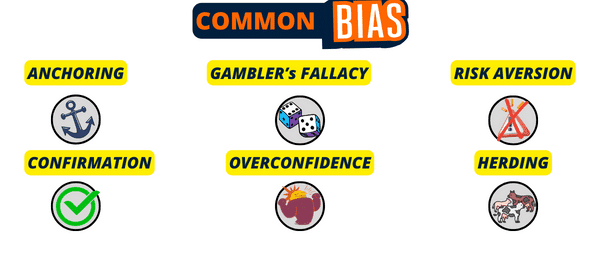Psychology is an important part of day trading and investing. In most cases, even the most successful traders often make mistakes because of their emotions. The two most important psychological issues when trading are fear and greed.
Fear is seen in many ways, such as when a trader exits a losing trade prematurely or when they are afraid of entering a trade. Green is manifested in various ways like when a person overtrades, follows the crowd, uses excessive leverage, and opens super-sized trades.
This article will focus on another area in psychology known as biases. These are emotional features that can lead to substantial mistakes in the market. Many excellent traders have lost a fortune because of these biases.
Table of Contents
Definition of biases in day trading
Biases are important emotional features that all day traders and investors should be aware of. Failure do so can lead to major losses in the near or long-term basis. Bias is defined as a situation where an investor makes a decision not based on fact but because if their pre-conceived ideas.
There are numerous types of biases in psychology. Some of the most popular of these biases are:
- cognitive
- social
- institutional
- unconscious bias
In day trading and investing, the biggest concern is cognitive bias, which is defined as biases that emerge from the way our brains process information.
As a day trader or investor, it is very important for you to understand these biases early in your career. Doing so will help you avoid making common mistakes that many market participants make.
Examples of biases in day trading

There are many types of biases in both day trading and investing. Some of the most popular ones are:
Anchoring bias
Anchoring bias is a psychological situation where you rely too much on the first information that you receive, while often ignoring or underestimating what follows.
For example, a trader can decide to place a buy trade when a company releases strong financial results. While a stock will often jump immediately after that news, at times, it could drop during the earnings call.
Gambler’s fallacy
Gambler’s fallacy is another type of bias in the market. This is a situation where a trader makes a decision based on the recent performance.
For example, if a stock rises for four days straight, a trader can assume that it will drop sharply the following day. This is wrong since the stock can continue rising for more days.
Risk aversion bias
Risk aversion is a situation where a trader is afraid of taking risks in the market. For example, if a stock is in a bull run, a risk averse trader may be afraid of entering the trade fearing that it will soon reverse.
In most cases, risk-averse investors allocate cash in relatively safe assets like high-grade bonds, money market funds, and certificates for deposits. At times, they miss the ongoing rally in the stock market.
Confirmation bias
Confirmation bias is a situation where a trader makes decision based on what other people are saying.
For example, the trader or investor will often buy stocks with more buy ratings from analysts and short those with more sell ratings. At times, the opposite scenario can be the best option.
Related » Are confirmation signals really good?
Overconfidence bias
The other popular type of bias is known as the overconfidence bias. It is an emotional bias where you assume that you have better skills than other people.
Often this effect comes from a streak of positive trades (not even too long), and can lead the trader to trust his instincts by glossing over the analysis phase. A good example of an investor with high overconfidence bias is Cathie Wood, the founder of Ark Invest.
Herding bias
This is a situation where people believe that more people are correct than fewer ones. As a result, some stocks tend to be highly crowded, which leads to pricey valuations.
For example, a company like Nvidia has a price-to-earnings (PE) of 100, making it highly expensive. You know the phrase “I did it because everyone is doing it“? That is exactly what herding bias means.
Impact of biases in day trading
Biases have major impacts on both day traders and investors. The most important impact is where a trader makes losses because they did not follow the required analysis method.
For example, a trader with a herding bias will often follow the crowd while ignoring the four phases of the Wyckoff Method. These phases are accumulation, markup, distribution, and markdown.
As a result, they buy when the stock is rising and hold it when it moves into the distribution and markdown phase.
There are other examples of how biases can affect day traders. For example, a trader with a confirmation bias will buy a stock because an analyst recommended it. While some analyst recommendations can work well, in most cases, they can lead to substantial losses.
These biases can also lead to other psychological issues like stress and depression. They can also cause many experienced traders to make major losses in the market.
How to solve emotional and cognitive biases in trading
There are several strategies that will help you solve emotional biases in day trading. The most important approaches are:
Set and follow your trading rules
One of the top approaches to avoid these cognitive issues is to set and follow your trading rules. For example, you can set a rule where you must conduct a multi-timeframe analysis before you execute a trade. Also, you can have the rule of always using a trading journal when trading.
Setting rules is the first part. You should ensure that you follow them well. For example, if you are using the VWAP indicator, you can have a rule where all buy trades are executed when it moves above the indicator.
Risk management strategies
The other approach of solving biases is to ensure proper risk management strategies. Some of the top strategies that will help you with this are:
- using the right leverage size
- position sizing
- having a stop-loss and a take-profit
Proper risk management will help you limit the size of your loss when you make a biased mistake.
Knowing yourself
You can also avoid these common biases by reflecting and knowing more about yourself. Reflecting on yourself can help you identify these biases and then work on them.
In most cases, dealing with these biases will not be easy. For example, it is often not easy to avoid herding biases when a stock is soaring.
Focusing on your strategy
The most important thing you need to do when day trading is the need to have a good strategy. You should create this strategy and test it in a demo account before you decide to move to a live account.
Creating a solid strategy will help you avoid these biases. As with the rules, you should also ensure that you follow the strategy.
There are other approaches that will help you deal with these biases when day trading and investing. For example, emotional control, taking small losses, and diversifying your trades will go a long way in this.
Further, some technologies and trading strategies can help you deal with these biases. One of the top approaches is to use automated trading platforms like bots to do that.
If you believe that you cannot overcome these biases, we recommend that you use the copy trading strategy. This is a situation where you use a platform that lets you copy from other traders.
Final thoughts
Emotional and cognitive biases are some of the most important psychological things you should always consider when trading.
Failure to understand these biases can see you make substantial losses even when you have excellent technical and fundamental trading skills.
External useful resources
- How to improve your trading bias – IG



